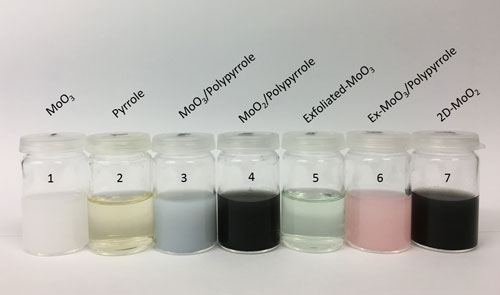| Posted: Feb 15, 2018 | |
Fabricating 2D nanosheets from non-layered materials |
|
| (Nanowerk Spotlight) Ever since the first exfoliation and identification of graphene in 2004, researchers also have attempted to make two-dimensional (2D) nanostructures from naturally non-layered compounds – i.e. to produce 2D nanostructures from any material that is not naturally layered. | |
| In a new paper in Nano Letters ("Anomalous Li Storage Capability in Atomically Thin Two-Dimensional Sheets of Nonlayered MoO2"), researchers now report a systematic study involving theoretical and experimental approaches to evaluate the Li-ion storage capability in 2D atomic sheets of nonlayered MoO2. | |
| "We were interested in making 2D nanosheets of MoO2 because it is a metallic conductor, unlike most oxides," Husam N. Alshareef, a Professor of Materials Science & Engineering at King Abdullah University of Science & Technology (KAUST), tells Nanowerk. "We thought since MoO3 is a layered material, we could first make 2D sheets of MoO3, and then use polymerization reaction to reduce MoO3 to 2D MoO2, while retaining the 2D sheet morphology. We were right – our polymer-assisted approach is totally new." | |
| In their paper, the KAUST team describes a new process – polymer-assisted reduction – to make atomically flat 2D sheets of MoO2. The KAUST team collaborated with colleagues at University of Electronic Science and Technology of China, Chengdu, who carried out theoretical calculations that matched very well with experiments, and with colleagues at Saudi Basic Industries Corporation (SABIC) who helped with chemical synthesis. | |
 |
|
| Images taken at the various stages of the MoO2 synthesis process. (Image: KAUST) (click on image to enlarge) | |
| Since MoO2 is not a 2D material, this process opens a new pathway to make 2D nanostructures from non-layered materials. | |
| "The most interesting aspect of the process we have developed is that it can work with other material systems," Alshareef points out. "In principle, we can now produce two dimensional nanostructures from many materials that are not naturally layered." | |
| By successfully making 2D atomic sheets of MoO2, the researchers fabricated a battery electrode in which the Li ion diffusion and electron transport are exceptionally fast. | |
| The 2D nanostructure enhances Li diffusion which increases Li storage capacity and rate performance of the battery. The 2D structure also reduces structural distortion in battery anodes that work by conversion reactions. In case of MoO2, there is another advantage: MoO2 is a metal, so electrons move through it fast. | |
| "Our 2D MoO2 electrodes have achieved significantly higher Li storage capacity, rate capability, and cycling stability thanks to their ability to transport ions and electrons very fast," says Chuan Xia, PhD student and lead author of the paper. "The metallic nature of MoO2 moves the electrons fast. The two 2D topology moves the ions fast, and minimize structural distortion during the lithiation process." | |
| For this reason, the team achieved significantly higher Li storage capacity in MoO2 compared to bulk (large-particle) MoO2. Specifically, they achieved 1516 mAh g-1 (compared to the theoretical limit of bulk MoO2 of 830 mAh g-1) after 100 cycles at the current rate of 100 mA g-1 and 489 mAh g-1 after 1050 cycles at 1000 mA g-1. | |
| In addition, the MoO2 electrodes showed excellent cycling stability, retaining 86% of initial charge up to 10000 cycles. This is impressive since most battery electrodes cannot last that long. | |
| The team's fabrication process – which is general can make layered nanostructures from non-layered materials – can be applied to oxides, sulfides, selenides, etc. | |
| "Since 2D topology has resulted in exciting properties of 2D materials, with our process we extend this potential for finding exciting properties to many materials that are not naturally layered," Alshareef points out. | |
| Already, the researchers have successfully applied this process to other compounds and they are studying their electrical, optical, and energy storage properties. | |
 By
Michael
Berger
– Michael is author of three books by the Royal Society of Chemistry:
Nano-Society: Pushing the Boundaries of Technology,
Nanotechnology: The Future is Tiny, and
Nanoengineering: The Skills and Tools Making Technology Invisible
Copyright ©
Nanowerk LLC
By
Michael
Berger
– Michael is author of three books by the Royal Society of Chemistry:
Nano-Society: Pushing the Boundaries of Technology,
Nanotechnology: The Future is Tiny, and
Nanoengineering: The Skills and Tools Making Technology Invisible
Copyright ©
Nanowerk LLC
|
|
|
Become a Spotlight guest author! Join our large and growing group of guest contributors. Have you just published a scientific paper or have other exciting developments to share with the nanotechnology community? Here is how to publish on nanowerk.com. |
|
